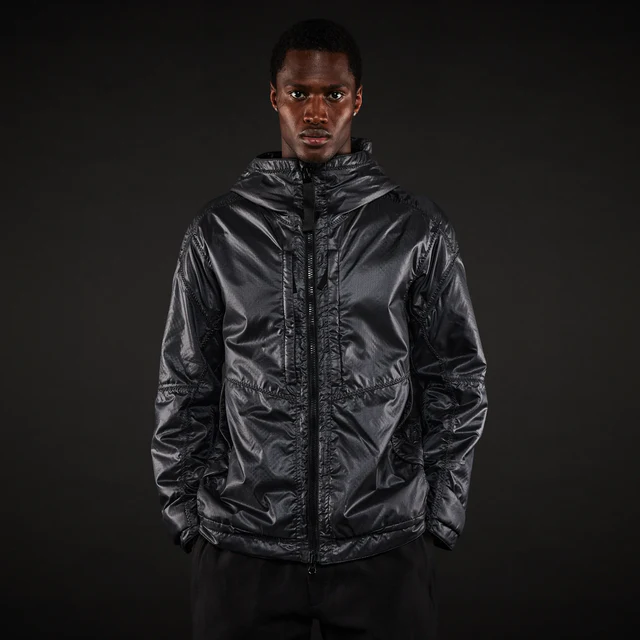
While graphene’s existence was first theorised in the 1940s, it wasn’t until 2004 that two maverick scientists at the University of Manchester – Andre Geim and Konstantin Novoselov – were able to isolate and test it. During their highly speculative ‘Friday night experiments,’ they peeled layer after layer off a shaving of graphite using Scotch tape until they produced a sample of graphene just one atom thick.
In 2010 their work won them the Nobel Prize.
Today the University of Manchester is the home of graphene. The National Graphene Institute and Graphene Engineering and Innovation Centre are dedicated entirely to working on the future of the supermaterial. And for the past 3 years we’ve been working with Professor Coskun Kocabas and his team at the NGI, using graphene as the base for the world’s first Thermal Camouflage Jacket.
While the jacket is still in development – and we can’t make anyone disappear just yet – we wanted to share our progress. Because today’s prototype proves the viability of wearable thermal camouflage for the first time.
The Thermal Camouflage Jacket is the first computer-programmable jacket, as well as a first step towards an invisibility cloak, because in infrared you can program entire parts of it to simply disappear.
On the front of the jacket are 42 graphene patches that can be controlled individually just like pixels. Every patch is made up of over 100 layers of pure graphene. And they control thermal radiation on the jacket’s surface without changing its temperature.
To demonstrate the degree to which we can control the thermal radiation emitted by the jacket, we spent a week writing code that would allow us to play Tetris in infrared. So instead of seeing heat radiating from a human body, the camera simply sees the pattern of a 1980s computer game.
We start by uploading code from the computer to a microcontroller on the jacket. Gold and copper printed wiring runs to each graphene patch, applying voltage to them. The voltage forces ions between the graphene layers using ionic liquid. And the more ions you push between the graphene layers, the less thermal radiation it emits and the colder it looks.
The key detail is that every single patch can be programmed individually to emit a different level of thermal radiation. And this is the way it can blend into its surroundings and appear invisible to infrared cameras.
Over the next decade, as we scale the technology up and scale the size of the graphene pixels down, theoretically you should be able to hide anything. With enough patches and enough power, a person could simply blend into a forest. Or a plane could blend into a runway.
And while the Thermal Camouflage Jacket only operates on the infrared spectrum today, by using graphene, it should ultimately be possible to build a version that also operates on the visible spectrum at the same time.
Graphene is a highly tuneable material, which means that applying energy to it changes how it appears on both the infrared spectrum and the visible spectrum. So theoretically at least, changing the charge density of the graphene will change the colour we see. And once you’ve got one device that controls all wavelengths, that’s when the possibility of building an invisibility cloak starts to become very real.
We know the future doesn’t build itself. Someone has to take the first step. Flying cars and invisibility cloaks aren’t going to magically appear by themselves just because we read about them as kids. So having already built clothing for climate change, space colonisation, and the Apocalypse, an invisibility cloak was always going to be next on our list.
Building one in the real world is naturally a lot harder than it looks in the films, as you run straight into two interconnected problems.
The first is that it’s not enough to hide a human on the visible spectrum. We’ve been doing variations of that for tens of thousands of years by hiding in bushes or in the shadows to hunt prey. You have to hide them on the infrared spectrum too. And human beings are really bright on infrared cameras. We radiate around 200 watts. So if you’re going to try and hide someone – which is the whole point of an invisibility cloak – you have to start by hiding them on the infrared spectrum. Which is why we’ve started there.
The second problem is that to hide someone on the infrared spectrum, you need to build something that’s half clothing and half machine. And that’s not something that’s really been done before. Electronic devices and fabric are historically incompatible. Very simply one is hard, and the other is soft, which creates a huge number of interdisciplinary challenges.
So for the last 3 years we’ve been bringing together the fields of physics, optical materials, electronic control systems, textiles and engineering, to create a single piece of clothing that someone can actually wear, that is also an advanced optical device.
Today it’s simply a proof of concept, and the jacket is not for sale. But hopefully we’re on our way to creating something so advanced that you’ll never actually see it.











